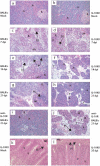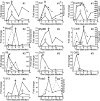IL-10 is pathogenic during the development of coxsackievirus B4-induced chronic pancreatitis
- PMID: 19800092
- PMCID: PMC2783446
- DOI: 10.1016/j.virol.2009.09.005
IL-10 is pathogenic during the development of coxsackievirus B4-induced chronic pancreatitis
Abstract
Using a mouse model of coxsackievirus B4 (CVB4-V)-induced chronic pancreatitis, we investigated whether cytokines are involved in the progression of acute disease to chronic inflammatory disease. We show that IL-10 contributed to the development of chronic pancreatitis since acute disease resolved when IL-10 was absent or when IL-10 signaling was disrupted. We explored the underlying mechanisms by which IL-10 affected disease progression, using a novel approach to assess immunological events occurring in situ. Multiple markers that define functional innate immune responses and functional T cell responses were monitored over the course of CVB4-V infection of wild-type and IL-10 knockout mice, using a multiplex transcriptional profiling approach. We show that high levels of IL-10 early during infection were associated with delayed innate and T cell responses. Furthermore, high IL-10 production correlated with altered kinetics of T regulatory responses indicating a disruption in the balance between effector and regulatory T cell responses.
Figures





References
-
- Chapman NM, Kim KS. Persistent coxsackievirus infection: enterovirus persistence in chronic myocarditis and dilated cardiomyopathy. Curr.Top.Microbiol.Immunol. 2008;323:275–292. - PubMed
-
- Couper KN, Blount DG, Riley EM. IL-10: the master regulator of immunity to infection. J.Immunol. 2008;180:5771–5777. - PubMed
-
- Curotto de Lafaille MA, Lafaille JJ. Natural and adaptive foxp3+ regulatory T cells: more of the same or a division of labor? Immunity. 2009;30:626–635. - PubMed
Publication types
MeSH terms
Substances
Grants and funding
LinkOut - more resources
Full Text Sources

